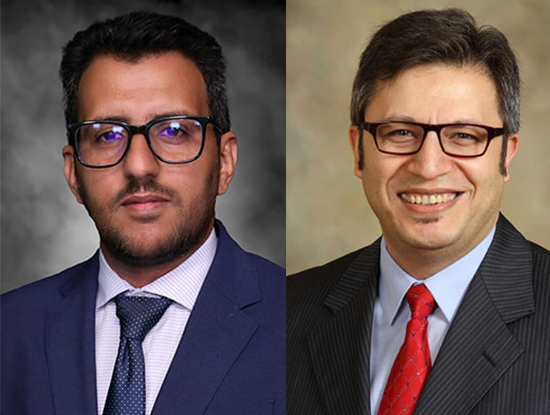Media Contact: Adam Pope
 Abdulaziz Ahmed, Ph.D. and Bunyamin Ozaydin, Ph.D.A group of University of Alabama at Birmingham researchers have been awarded $1 million to develop and implement solutions to reduce emergency department overcrowding.
Abdulaziz Ahmed, Ph.D. and Bunyamin Ozaydin, Ph.D.A group of University of Alabama at Birmingham researchers have been awarded $1 million to develop and implement solutions to reduce emergency department overcrowding.
“This is definitely a significant topic and an important societal problem,” said Abdulaziz Ahmed, Ph.D., associate professor in the UAB School of Health Professions and associate scientist in the Center for Clinical and Translational Science. “We are all excited to be tackling something that can be so impactful for so many people.”
The research will use artificial intelligence, machine learning and health information technology to analyze the full capacity protocol in managing patient flow in the ED and beyond. The FCP consists of multiple levels, each triggered by specific criteria. When a level is activated, various interventions can be implemented to address ED crowding.
Currently, most hospitals adopt a reactive approach, waiting until the ED is crowded before deploying resources to mitigate the issue. In contrast, this project aims to leverage AI and machine learning to transform the FCP into a proactive protocol that anticipates crowding using different AI models.
“This is a problem facing every health system around the world. There is not one universal protocol,” Ahmed said. “Plus, not every hospital even has an FCP.”
Bunyamin Ozaydin, Ph.D., who has extensive system development experience in the UAB Marnix E. Heersink School of Medicine Department of Anesthesiology, emphasizes that ED overcrowding is not solely an ED problem but rather a hospital wide issue affecting patient flow.
“After leaving the operating room, surgical patients go into post-op or ICU, then some go to inpatient units, and those are the same destinations for admitted ER patients,” Ozaydin said. “That is why we’re looking at this more holistically and looking at more of the overall hospital patient flow.”
Artificial Intelligence and Machine Learning
Shortly after joining the HSA department, Ahmed gave a presentation at the CCTS, where he discussed the research he conducted, predicting ED admission disposition at the time of triage. His work was to be a possible solution to reduce boarding time and consequently reduce overcrowding.
Ahmed connected with James Booth, M.D., associate vice chairman of the UAB Department of Emergency Medicine and interim chief medical information officer of the UAB Health System, about the impracticality of focusing solely on anticipating patient outcomes without considering the use or lack of use of an FCP. After extensive discussion, they agreed to collaborate and proposed shifting from reactive strategies to proactive solutions.
“In the simplest terms, we decided to use AI and machine learning to leverage reactive FCP and make it proactive,” Ahmed said. “We plan to use a deep learning model to predict different patient flow measures across the hospital and then package all these models to feed data automatically into a decision support system, which is a dashboard that can be integrated with the set of tools the patient flow management team utilizes.”
Simulation, Then Implementation
The team will focus on the conceptualization and development of the process and procedures in the first two years of the grant. During this time, the UAB team will study the effectiveness and feasibility of proactive FCP that is supported by AI.
“The models are the engine of the car, but an engine alone doesn’t get you there — you have to build a car that is actually drivable,” said Ozaydin, who holds a master’s degree in electrical engineering and a doctoral degree in computer engineering. “For that, we need a substantial system with input interfaces, output interfaces, user requirements, user interfaces and more built around the models.”
The proactive FCP simulation will compare the system prediction model outcomes with the reactive outcomes to evaluate the effectiveness of the proactive FCP before its full implementation. Once the models reach a certain maturity level, they will be launched live.
During the last three years of the study, they will focus on establishing a proof-of-principle by implementing their models at three hospitals. The selection of multiple sites will enable them to generalize the system as much as possible and to study configuration settings specific to a particular organization.
“We will do the customization for the first site, and then we will do it at the other sites so we can understand what parameters need to be generalized, which will help us better understand how our solution can be implemented at any given hospital,” Ozaydin said. “There are many very complex processes in health care that could be improved. Our project further signifies the importance of AI in positively impacting everyone’s lives and how it can be used to tackle many problems across health care.”
Their preparation for this work has already begun, and they are excited for the future. Although it will take time to see and then implement results, they firmly believe this is a strong step forward. They see their work as having the potential to help many patients soon. Even more importantly, they hope it can provide much needed insight to practitioners and other researchers for many years to come.
Ahmed, contact principal investigator; Ozaydin, multi-principal investigator; and Eta S. Berner, Ed.D., co-investigator; in the UAB Department of Health Administration, along with Booth, co-investigator in the Department of Emergency Medicine, are the investigators of a five-year grant awarded by the Agency for Healthcare Research and Quality.